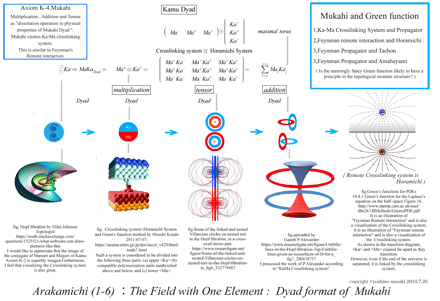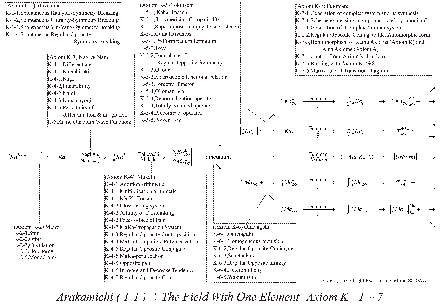Kamu Number Theory
| Contents |
|
Preface
|
| Summery |
|
1.Kamu Axiom system
|
|
2.Kamu Dimension system
|
|
3.Space Time compatible Quantum
|
|
4.Topological model of Ama Universe
|
| Kamu Number Theory |
| ver.2019.10 |
| Masaki Yoshino |
| Masaki Yoshino |
| site opned 2019.2.20 |
| studying Similarity schem theory from 1975 |
| copyright (c) 2019 all rights rezerved |
| blog in English and Japanese |
Addition arithmetic and Multiplication arithmetic
| New pdf 1-1-9.Futomani 1-1-8.Pair Production 1-1-7.Super Duality 1-1-6.Dyad 1-9-1.What is Ka ? 1-9-2.What is Ka & Ma 1-9-3.What is Ma ? |
| Chapter Index |
|
A4 size pdf Plate Index
|
| Preface |
| Summery |
|
|
|
1.Kamu Axiom System
|
|
|
|
1-1.Construction of Axioms
1-1-1.Axiom K and Axiom A 1-1-2.Field with one Element 1-1-3.Kamu Postulate |
|
1-2.Axiom from K1 to K8
1-2-1-1.K1,MaKaTama Symmetry 1-2-1-2.K1,spontaneous symmetry breaking 1-2-1-3.K1,UrForm and Prototype 1-2-2.K2,Mawari & Rotation 1-2-3.K3,differentiation and integration 1-2-4.K4,Kamu addition and multiplication 1-2-5.K5, Tokotachi Super Duality 1-2-6.K6, Pair Production 1-2-7.K7, Futomani 1-2-8.K8,Yata Phenomenon generation Field 1-2-9-1.What is Ka ? 1-2-9-2.What is Ma ? |
| 1-3.Axiom from A1 to A8 1-3-1.A1,Dynamic Saturation Stability 1-3-2.A2,Ama differentiation and integration 1-3-3.A3,Potential automorphic 4 Phases 1-3-4.A4,Tabane & Formal Power Series 1-3-5.A5,Imatachi & logic of Life. 1-3-6.A6, Compatibility and Duality 1-3-7.A7,Oho & Kamu forgetful Functor 1-3-8.A8,Kamuutsusi & Amautsushi |
| 1-4.Symboles inTransition Diaguram 1-4-1.First Reconsider the Operation 1-4-2.Compatible and Polymetric Additive operation 1-4-3.To Caputure Differenntial Integral with a wave image 1-4-4.Tranqull operation and Tropical Geometry |
| 1-5.Potential cuspidal automorphic form 1-5-1.Making an illustration of "Magatama Symmetry" of Axiom K-1 becomes Cuspidal automorphic form 1-5-2. Cuspidal automorphic form genetically dominating "Axiom A" |
| 1-6. Kamu imaginary Diamond and mirror symmetry 1-6-1. |
| 1-7. Axiom K-5 & 6 and the way to Carabi-Yau manifold 1-7-1. |
| 1-8. Carabi-Yau manifold to E8 Transition process and Axioms K8 |
| 1-9. Axiom A and Lie group U (1), SU (2), SU (3) |
| 1-10. Kamu Rosetta Stone |
| 1-11. Kurokawa multiple trigonometric function model |
| 1-12.Relativity-Capacitive-Quantity and Entropy 1-12-1.Reforming Boltzmann's Entropy definition formula and Information Thermodynamics 1-12-2.Guage Space and Relativity-Capacitive-Quantity |
| 1-13. Newton's map Model of Zeta function |
| Here, we will mainly look at addition and multiplication, which are operations that have been incorporated into the physical properties of Mukahi. | |
| Latent-Phenomenon's <Ka> has created a phenomenon system <Ma> that is still latent at this stage “within its own <Mari manifold>” by spontaneous symmetry breaking.This was the physics from the axiom K-1 to the axiom K-3. | |
| As a result, the negative nature of <Ka> and the positive nature of <Ma> will "face each other" in one <Mari-Manifold>.The Axiom K-4 is to establish as an axiom the physics that arise from this "positive and negative face each other". | |
| S. Narasaki analyzed "Phenomenal system and latent system face each other" or "Latent-Phenomenon like opposite" as "Diad".If you consider <Ma> and <Ka> as <± Ma> and <± Ka> and treat them like complex numbers, "Dyad" will appear. | |
| It is a "MaKa tensor" in which "orthogonal MaKa" is arranged in each combination.In the physical property of <Mukahi>, "Dyad" is latent as "dissolution calculation in physical properties". | |
| The Dyad that appear in the form of this tensor can show addition and multiplication as forms dissolved in the "MaKa tensor".Please refer to pdf.1-1-6.Dyad. | |
| The inside of "MaKa tensor" shows a structure that can be called "MaKa Crosslinking System".According to the Axiom K-6.Ometaguhi, MaKa transits, separates and becomes independent.However, the Crosslinking System continues even after separation. | |
| The separated <Ka> and <Ma> are tightly coupled to each other by "remote interaction".This structure is what is called "Horamichi" in Kamu Number Theory.The remote interaction has a structure that transcends "field" but does not deny "field". | |
| I would like to focus on the analysis of remote interaction using Green's function in Feynman's early work.I think Green's function as a 'propagation function' can give an analytical representation of 'Horamichi'.In addition, I would like to see the details of "Horamichi" in Part 4 of Kamu Number Theory. | |
| Kamu Axiom K-4 List | |
| Axiom K-4 . Mukahi K-4-1,Addition arithmetic K-4-1,Multiplication arithmetic K-4-1,Ma-Ka Tensor K-4-2.Closslinking system K-4-2.Affinity of Closslinking K-4-2,Face-to-face of Pair K-4-2,MaKa-Propagation System K-4-3,Regular-Opposite Contraposition K-4-4,MaKa-Compatible Polymerization K-4-5,Regular-Opposite-Conjugate K-4-5,MaKa-perturbation K-4-5,Opposite pair K-4-6,Increase and Decrease Tendency K-4-7,Regular-Opposite-Consort |
|
|
|
|
 |
|
|
 |
| pdf.Arakamichi 1-1-1.Axiom K-1~K-7 |
 |
| pdf.Arakamichi 1-1-4.Kamu-Calabi-Yau manifold |
|
|
| New pdf 1-1-9.Futomani 1-1-8.Pair Production 1-1-7.Super Duality 1-1-6.Dyad 1-9-1.What is Ka ? 1-9-2.What is Ka & Ma 1-9-3.What is Ma ? |